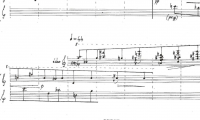Concert with commentary in Opéra de Lille
PROGRAMME
Tristan Murail, Territoires de l'Oubli, 1977
CAST
Fabian Coomans, piano
Jean-Luc Fafchamps, commentary
Note by Julian Anderson
(from the Tristan Murail website)
Territoires de l'oubli was written in 1977 for the French composer-pianist Michaël Lévinas, who gave the first performance in Rome, in 1978. This piece, Murail's longest single-movement work to date, is a massive exploration of the piano's resonance, unfolding in a huge curve of continuously evolving textures. Murail has remarked of the piece that "instead of considering the piano as a mere percussion instrument (hammers hitting strings), Territoires emphasizes a different idiomatic characteristic of the instrument: a group of strings whose vibration is caused by sympathetic resonance or by direct action of the hammers." Murail further notes that the work is written "for the resonances, not the attacks which are considered as "scars" on the continuum." For this reason, the sustaining pedal is held down throughout the entire piece. The work perpetually slides between regular, repetitive moments of stability, and chaotic, dense textures which often approach noise. The most stable moments often make a special feature of iambic, "heart-beat" rhythms. The work constantly plays upon the ambiguity between harmony and timbre - the harmony is chosen according to the resonance characteristics of the piano, producing several striking transformations of the piano's sound: for example, at the end of the work, a form of "vibrato" is obtained by playing a fundamental simultaneously with an E-flat acting as its seventh harmonic. The true intonation of the seventh harmonic, heard in the resonance of the fundamental, beats against the equally tempered E-flat in the piano's tuning. At several points in the piece, clusters of deep bass notes are heard, producing a mass of higher harmonics which form the basis of the harmony of the following section: in this way a continuous harmonic "chain" is built through out the work. The extreme continuity of Territoires does not prevent it from being one of Murail's most evocative and dramatic pieces, especially in the wild cadenza of descending and ascending chords near the end.
Julian Anderson
Note du compositeur
(disponible sur le site de Tristan Murail)
"En réaction contre une écriture percussive du piano courante à l'époque, Territoires de l'oubli renoue avec une certaine conception "lisztienne" de la virtuosité.
Le piano y est considéré avant tout comme un ensemble de cordes résonantes - la percussion des marteaux n'est que l'indispensable inconvénient qui permet de les mettre en vibration, directement ou par sympathie.
Les sons vibrent jusqu'à extinction naturelle, car la pédale est enfoncée pendant toute la pièce, sans jamais être relevée. Leur résonance décrit des territoires successifs, délimités par l'oubli des fréquences qui s'éteignent.
Le piano est aussi traité comme une sorte d'orchestre virtuel, démultiplié par des chambres d'écho imaginaires. Les phénomènes et processus sonores continus, possibles à l'orchestre mais non au piano, sont symbolisés par des systèmes de répétitions, des figures de virtuosité, des jeux de nuances superposées.
Le timbre et l'harmonie sont en relation étroite : les hauteurs sont souvent choisies en fonction des résonances naturelles du piano, qu'elles renforcent ou contrarient selon le sens de l'évolution (vers plus de simplicité ou vers plus de complexité).
En plus de difficultés pianistiques de caractère traditionnel, l'interprète doit contrôler sur de longues périodes la lente évolution de couches sonores qui se tuilent ou se superposent.
Tristan Murail
Agenda for this project
- Date Show Location
-
Wed 19.02 Territoires de l'oubli (concert with commentary) Opéra de Lille - Lille - France

Territoires de l'Oubli
start: 18h Concert with commentary in Lille Opera : Tristan Murail, Territoires de l'Oubli, 1977. Fabian Coomans, piano read more


